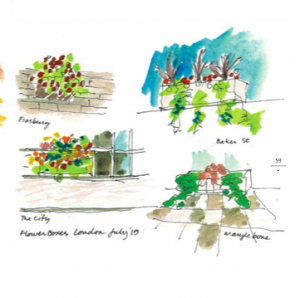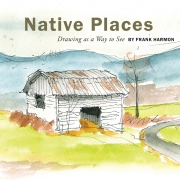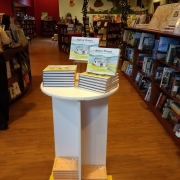‘Native Places’ is more than a book; it’s a devotional
Review by Eleanor Spicer Rice, Ph.D.

Carolina Wren by Frank Harmon
When marveling over Columbus, Indiana’s city structure, Frank Harmon points to the Finnish architect Alvar Aalto’s view that “architecture belongs to culture, not civilization.” In Native Places: Drawing as a Way to See, architecture belongs to Frank Harmon, and he gives it to us like a gift.
Each page of Native Places pairs one of Harmon’s charming illustrations with a vignette of his perspective, which magnifies the small (a Carolina wren perched on an excavator, for example), shrinks the large (Kansas and Georgia landscapes seen from an airplane window), and reveals the astonishing, functional beauty of each.
Like a child picking up fistfuls of seemingly commonplace stones, Harmon gathers places in all their forms and meanings and thoughtfully lays them in his book, where the ordinary becomes extraordinary and everyday life takes on a new texture and meaning.
In Native Places, architectural marvels can be obvious, like Thomas Jefferson’s Lawn at the University of Virginia, but they also can be the often-unnoticed quotidian, like window boxes along London’s streets. After all, great architects draw lasting monoliths, or they hammer planks on sensible barns. The resulting effect is an enrichment of the reader’s everyday experience, a wonderment over the human hand-sized bricks that stack up to form our homes or the bats roosting beneath the soffits.

Window boxes in London by Frank Harmon
Native Places is more than a book; it’s a devotional. The reader can pick it up and open to any page to find a complete and renewing story. It can be read in chunks or a page at a time. It can wait beautifully and patiently for casual readers on their coffee tables, or it can be an important bedside staple.
One last, but important feature of Native Places: Drawing as a Way to See is its author. As shorebirds and dustpans have made impressions on him, people across the world have experienced Harmon’s influence as an architect. Harmon’s architectural contributions include the AIANC building, his award-winning residences, and years as a sought-after professor at NC State University. The opportunity to explore a legendary influencer’s perception is a brilliant delight, one guaranteed to leave the reader feeling gratified and with a revitalized sense of awe, if we take the time to look.
__________________________________
Eleanor Spicer Rice, Ph.D., is Senior Science Editor for Verdant Word, specializing in communicating scientific ideas to a popular audience.











Leave a Reply
Want to join the discussion?Feel free to contribute!